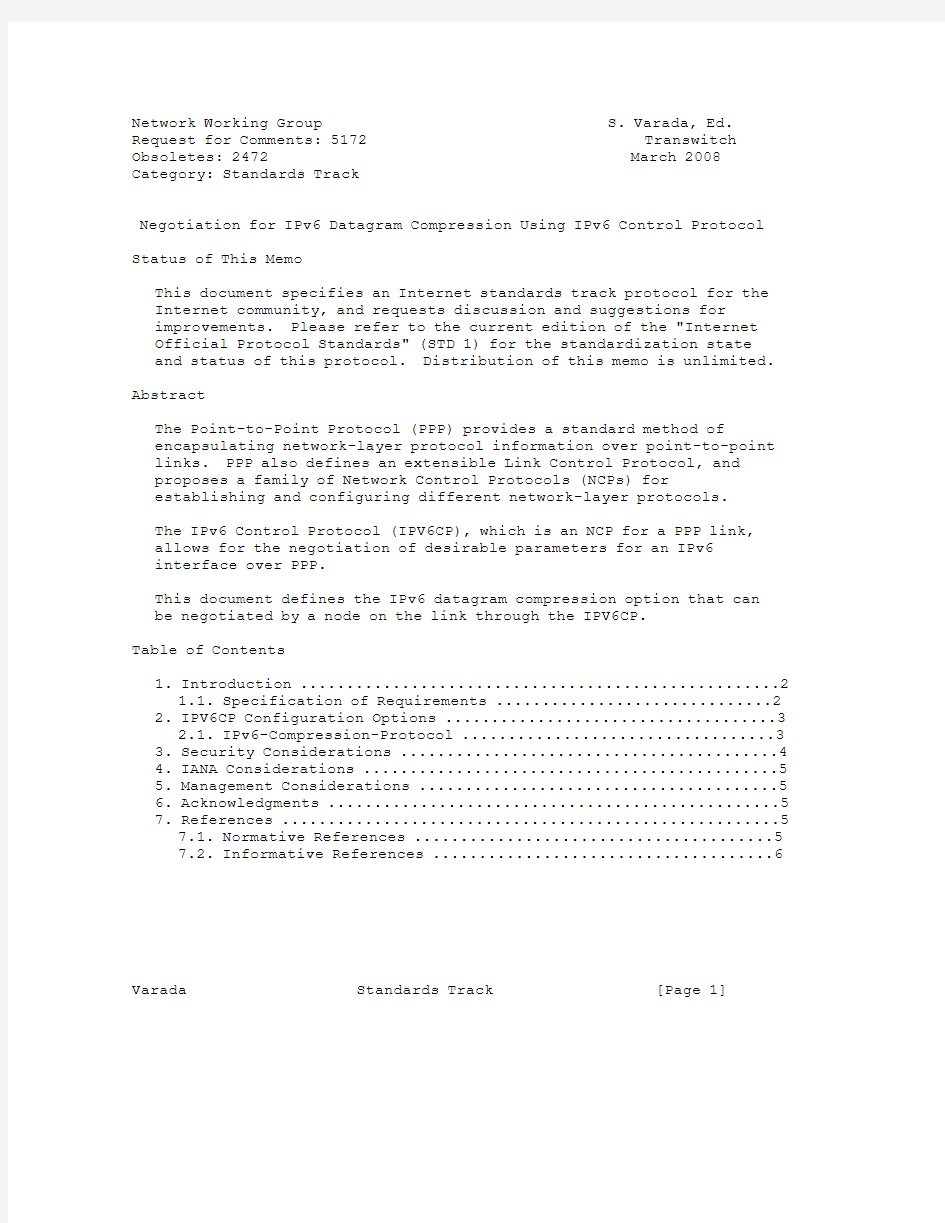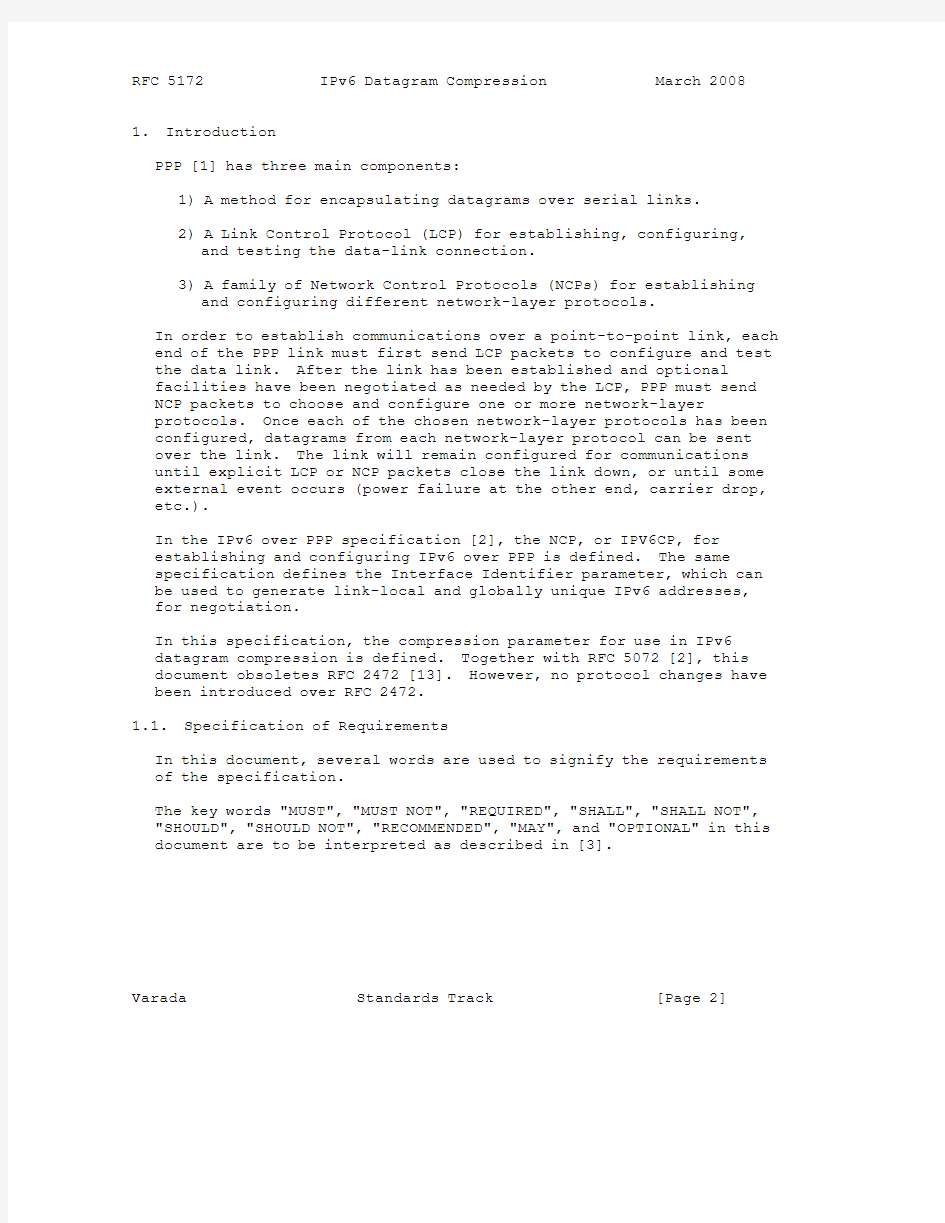

Network Working Group S. Varada, Ed. Request for Comments: 5172 Transwitch Obsoletes: 2472 March 2008 Category: Standards Track
Negotiation for IPv6 Datagram Compression Using IPv6 Control Protocol Status of This Memo
This document specifies an Internet standards track protocol for the Internet community, and requests discussion and suggestions for
improvements. Please refer to the current edition of the "Internet
Official Protocol Standards" (STD 1) for the standardization state
and status of this protocol. Distribution of this memo is unlimited. Abstract
The Point-to-Point Protocol (PPP) provides a standard method of
encapsulating network-layer protocol information over point-to-point links. PPP also defines an extensible Link Control Protocol, and
proposes a family of Network Control Protocols (NCPs) for
establishing and configuring different network-layer protocols.
The IPv6 Control Protocol (IPV6CP), which is an NCP for a PPP link,
allows for the negotiation of desirable parameters for an IPv6
interface over PPP.
This document defines the IPv6 datagram compression option that can
be negotiated by a node on the link through the IPV6CP.
Table of Contents
1. Introduction (2)
1.1. Specification of Requirements (2)
2. IPV6CP Configuration Options (3)
2.1. IPv6-Compression-Protocol (3)
3. Security Considerations (4)
4. IANA Considerations (5)
5. Management Considerations (5)
6. Acknowledgments (5)
7. References (5)
7.1. Normative References (5)
7.2. Informative References (6)
Varada Standards Track [Page 1]
1. Introduction
PPP [1] has three main components:
1) A method for encapsulating datagrams over serial links.
2) A Link Control Protocol (LCP) for establishing, configuring,
and testing the data-link connection.
3) A family of Network Control Protocols (NCPs) for establishing
and configuring different network-layer protocols.
In order to establish communications over a point-to-point link, each end of the PPP link must first send LCP packets to configure and test the data link. After the link has been established and optional
facilities have been negotiated as needed by the LCP, PPP must send
NCP packets to choose and configure one or more network-layer
protocols. Once each of the chosen network-layer protocols has been configured, datagrams from each network-layer protocol can be sent
over the link. The link will remain configured for communications
until explicit LCP or NCP packets close the link down, or until some external event occurs (power failure at the other end, carrier drop, etc.).
In the IPv6 over PPP specification [2], the NCP, or IPV6CP, for
establishing and configuring IPv6 over PPP is defined. The same
specification defines the Interface Identifier parameter, which can
be used to generate link-local and globally unique IPv6 addresses,
for negotiation.
In this specification, the compression parameter for use in IPv6
datagram compression is defined. Together with RFC 5072 [2], this
document obsoletes RFC 2472 [13]. However, no protocol changes have been introduced over RFC 2472.
1.1. Specification of Requirements
In this document, several words are used to signify the requirements of the specification.
The key words "MUST", "MUST NOT", "REQUIRED", "SHALL", "SHALL NOT",
"SHOULD", "SHOULD NOT", "RECOMMENDED", "MAY", and "OPTIONAL" in this document are to be interpreted as described in [3].
Varada Standards Track [Page 2]
2. IPV6CP Configuration Options
IPV6CP Configuration Options allow negotiation of desirable IPv6
parameters. IPV6CP uses the same Configuration Option format as
defined for LCP [1] but with a separate set of Options. If a
Configuration Option is not included in a Configure-Request packet,
the default value for that Configuration Option is assumed.
The only IPV6CP option defined in this document is the IPv6-
Compression-Protocol. The Type field for this IPV6CP Option is as
follows:
2 IPv6-Compression-Protocol
Note that the up-to-date values of the IPV6CP Option Type field are
specified in the on-line database of "Assigned Numbers" maintained by IANA [7].
2.1. IPv6-Compression-Protocol
This Configuration Option provides a way to negotiate the use of a
specific IPv6 packet compression protocol. The IPv6-Compression-
Protocol Configuration Option is used to indicate the ability to
receive compressed packets. Each end of the link MUST separately
request this option if bidirectional compression is desired. By
default, compression is not enabled.
IPv6 compression negotiated with this option is specific to IPv6
datagrams and is not to be confused with compression resulting from a compression method negotiated via the PPP Compression Control
Protocol (CCP) [12], which potentially affects all datagrams.
A summary of the IPv6-Compression-Protocol Configuration Option
format is shown below. The fields are transmitted from left to
right.
0 1 2 3
0 1 2 3 4 5 6 7 8 9 0 1 2 3 4 5 6 7 8 9 0 1 2 3 4 5 6 7 8 9 0 1
+-+-+-+-+-+-+-+-+-+-+-+-+-+-+-+-+-+-+-+-+-+-+-+-+-+-+-+-+-+-+-+-+
| Type | Length | IPv6-Compression-Protocol |
+-+-+-+-+-+-+-+-+-+-+-+-+-+-+-+-+-+-+-+-+-+-+-+-+-+-+-+-+-+-+-+-+
| Data ...
+-+-+-+-+
Type
2
Varada Standards Track [Page 3]
Length
>= 4
IPv6-Compression-Protocol
The IPv6-Compression-Protocol field is two octets and
indicates the compression protocol desired. Values for this
field are always the same as the PPP Data Link Layer Protocol field values for that same compression protocol.
IPv6-Compression-Protocol field values have been assigned in
[4, 5] for IP Header Compression (0061), and in [6] for Robust Header Compression (ROHC) (0003). Other assignments can be
made in documents that define specific compression algorithms. Data
The Data field is zero or more octets and contains additional data as determined by the particular compression protocol.
The default (in the absence of negotiation of this option) is to have no IPv6 compression protocol enabled.
3. Security Considerations
Lack of proper link security, such as authentication, prior to data
transfers may enable man-in-the middle attacks resulting in the loss of data integrity and confidentiality. The mechanisms that are
appropriate for ensuring PPP link security are addressed below
together with the reference to a generic threat model.
The mechanisms that are appropriate for ensuring PPP link security
are: 1) Access Control Lists that apply filters on traffic received
over the link for enforcing admission policy, 2) an authentication
protocol that facilitates negotiations between peers [8] to select an authentication method (e.g., MD5 [9]) for validation of the peer, and 3) an encryption control protocol that facilitates negotiations
between peers to select encryption algorithms (or crypto-suites) to
ensure data confidentiality [10]).
There are certain threats associated with peer interactions on a PPP link even with one or more of the above security measures in place.
For instance, using the MD5 authentication method [9] exposes one to replay attacks, in which an attacker could intercept and replay a
station’s identity and password hash to get access to a network. The user of this specification is advised to refer to [8], which presents a generic threat model, for an understanding of the threats posed to Varada Standards Track [Page 4]
the security of a link. The reference [8] also gives a framework to specify requirements for the selection of an authentication method
for a given application.
4. IANA Considerations
No specific action is needed for the assignment of a value for the
Type field of IPv6 datagram compression option specified in this
specification. The current assignment is up-to-date in the registry "PPP IPV6CP CONFIGURATION OPTIONS" for item IPv6-Compression-Protocol (2) at [7]. However, the RFC reference for that item has been
changed to 5172.
No action is needed either for the assignment of the IPV6-
Compression-Protocol values, as such values have already been defined by other documents listed in Section 2.1. Values for this field are always the same as the PPP Data Link Layer Protocol field values for that same compression protocol. As a result, future allocation of
these values is governed by RFC 3818 [11] that requires IETF
Consensus. Current values are in the registry "IPv6-Compression-
Protocol Types". However, the RFC reference for that registry has
been changed to 5172.
5. Management Considerations
From an operational point of view, the status of the negotiation and the compression algorithm on the link should be observable by an
operator managing a network. There is no standard management
interface that covers this at the time of the writing of this
specification.
6. Acknowledgments
The editor is grateful to Jari Arkko for the direction provided on
this document and James Carlson for helpful suggestions.
Acknowledgments are also due to D. Haskin and E. Allen for the
specification work done in RFC 2023 and RFC 2472.
7. References
7.1. Normative References
[1] Simpson, W., Ed., "The Point-to-Point Protocol (PPP)", STD 51,
RFC 1661, July 1994.
[2] Varada, S., Ed., Haskin, D., and E. Allen, "IP Version 6 over
PPP", RFC 5072, September 2007.
Varada Standards Track [Page 5]
[3] Bradner, S., "Key words for use in RFCs to Indicate Requirement Levels", BCP 14, RFC 2119, March 1997.
[4] Degermark, M., Nordgren, B., and S. Pink, "IP Header
Compression", RFC 2507, February 1999.
[5] Koren, T., Casner, S., and C. Bormann, "IP Header Compression
over PPP", RFC 3544, July 2003.
[6] Bormann, C., "Robust Header Compression (ROHC) over PPP", RFC
3241, April 2002.
7.2. Informative References
[7] IANA, https://www.doczj.com/doc/9c9682266.html,.
[8] Aboba, B., Blunk, L., Vollbrecht, J., Carlson, J., and H.
Levkowetz, Ed., "Extensible Authentication Protocol (EAP)", RFC 3748, June 2004.
[9] Rivest, R., "The MD5 Message-Digest Algorithm", RFC 1321, April 1992.
[10] Meyer, G., "The PPP Encryption Control Protocol (ECP)", RFC
1968, June 1996.
[11] Schryver, V., "IANA Considerations for the Point-to-Point
Protocol (PPP)", BCP 88, RFC 3818, June 2004.
[12] Rand, D., "The PPP Compression Control Protocol(CCP)", RFC 1962, June 1996.
[13] Haskin, D. and E. Allen, "IP Version 6 over PPP", RFC 2472,
December 1998.
Editor’s Address
Srihari Varada
TranSwitch Corporation
3 Enterprise Dr.
Shelton, CT 06484
US
Phone: +1 203 929 8810
EMail: varada@https://www.doczj.com/doc/9c9682266.html,
Varada Standards Track [Page 6]
Full Copyright Statement
Copyright (C) The IETF Trust (2008).
This document is subject to the rights, licenses and restrictions
contained in BCP 78, and except as set forth therein, the authors
retain all their rights.
This document and the information contained herein are provided on an "AS IS" basis and THE CONTRIBUTOR, THE ORGANIZATION HE/SHE REPRESENTS OR IS SPONSORED BY (IF ANY), THE INTERNET SOCIETY, THE IETF TRUST AND THE INTERNET ENGINEERING TASK FORCE DISCLAIM ALL WARRANTIES, EXPRESS OR IMPLIED, INCLUDING BUT NOT LIMITED TO ANY WARRANTY THAT THE USE OF THE INFORMATION HEREIN WILL NOT INFRINGE ANY RIGHTS OR ANY IMPLIED
WARRANTIES OF MERCHANTABILITY OR FITNESS FOR A PARTICULAR PURPOSE. Intellectual Property
The IETF takes no position regarding the validity or scope of any
Intellectual Property Rights or other rights that might be claimed to pertain to the implementation or use of the technology described in
this document or the extent to which any license under such rights
might or might not be available; nor does it represent that it has
made any independent effort to identify any such rights. Information on the procedures with respect to rights in RFC documents can be
found in BCP 78 and BCP 79.
Copies of IPR disclosures made to the IETF Secretariat and any
assurances of licenses to be made available, or the result of an
attempt made to obtain a general license or permission for the use of such proprietary rights by implementers or users of this
specification can be obtained from the IETF on-line IPR repository at https://www.doczj.com/doc/9c9682266.html,/ipr.
The IETF invites any interested party to bring to its attention any
copyrights, patents or patent applications, or other proprietary
rights that may cover technology that may be required to implement
this standard. Please address the information to the IETF at
ietf-ipr@https://www.doczj.com/doc/9c9682266.html,.
Varada Standards Track [Page 7]